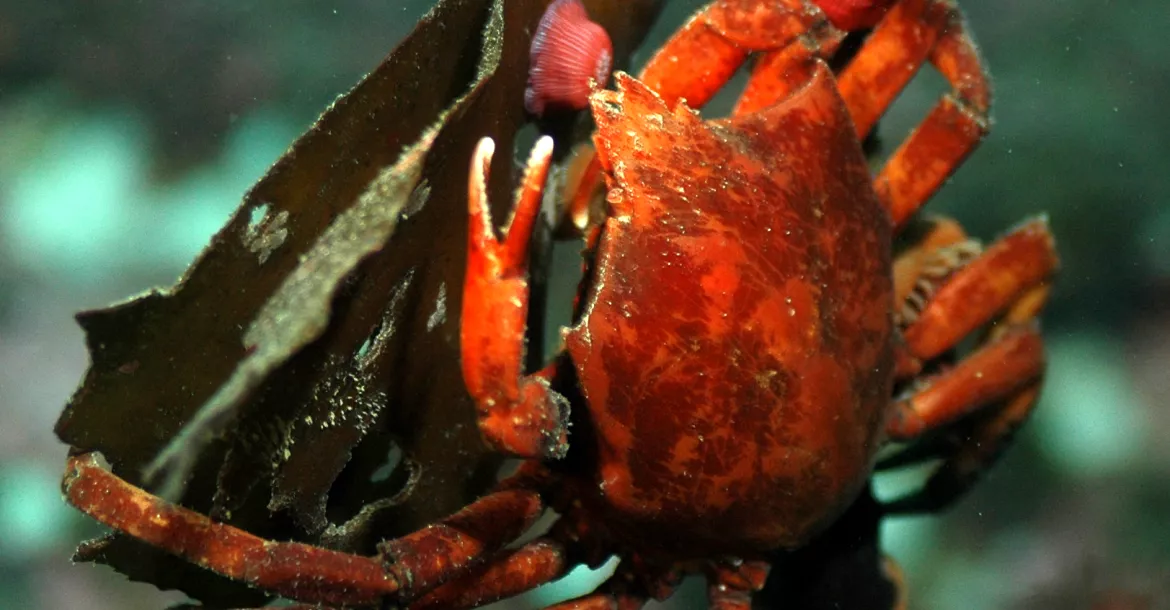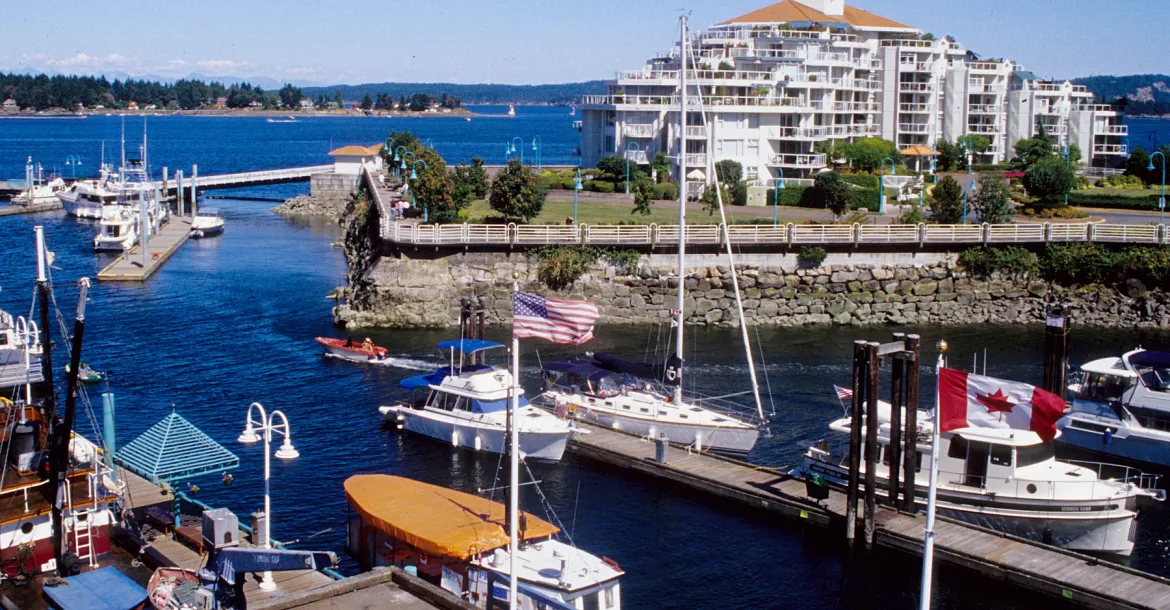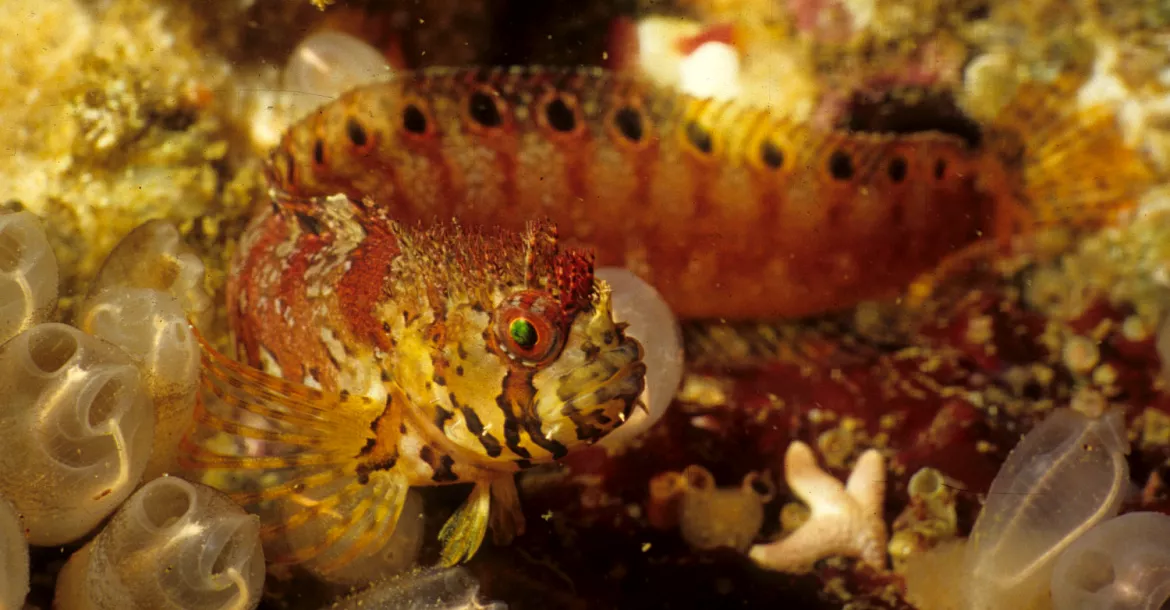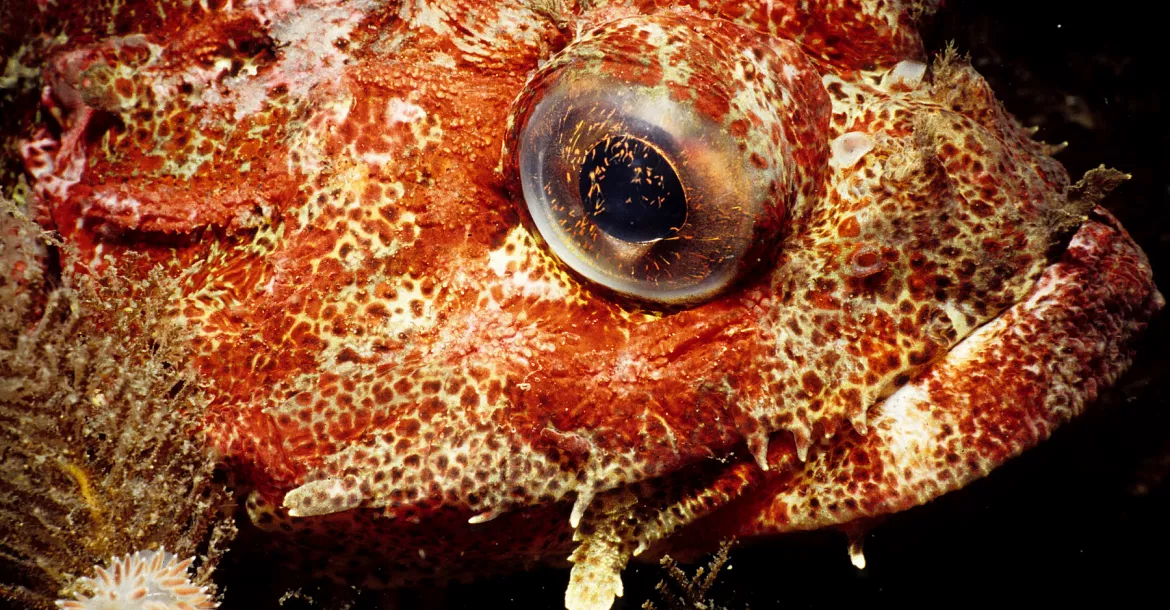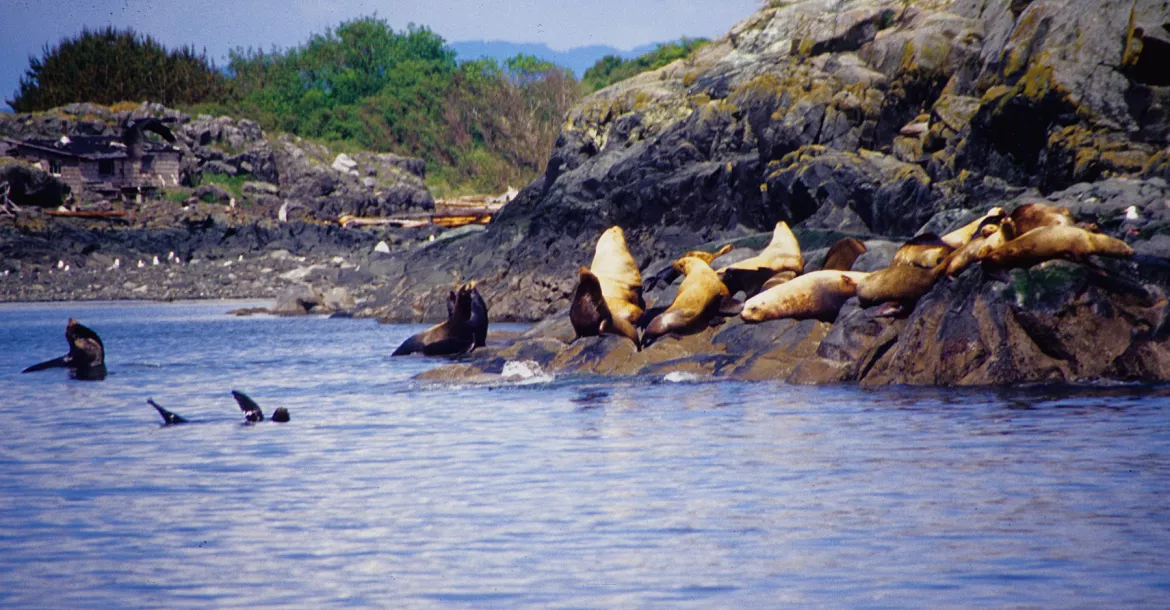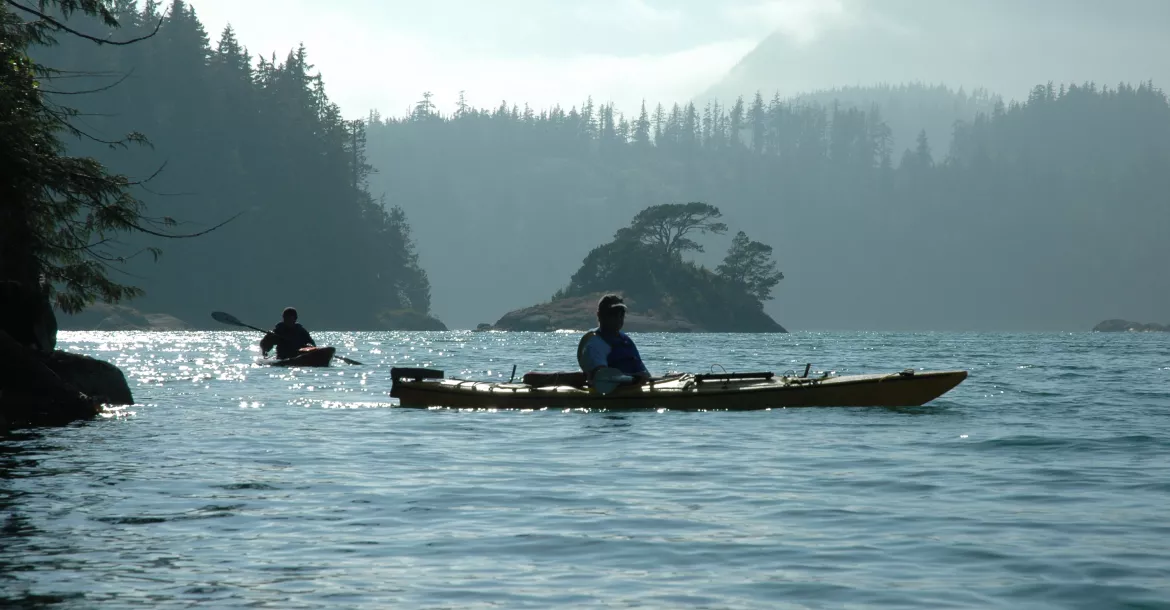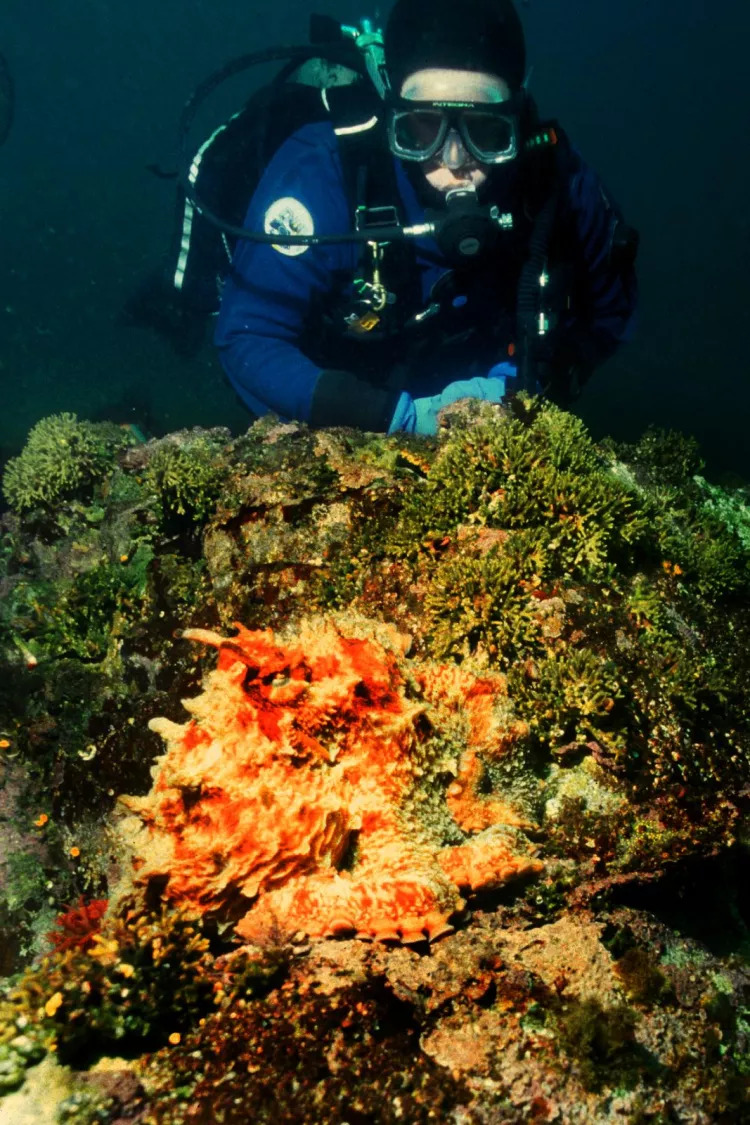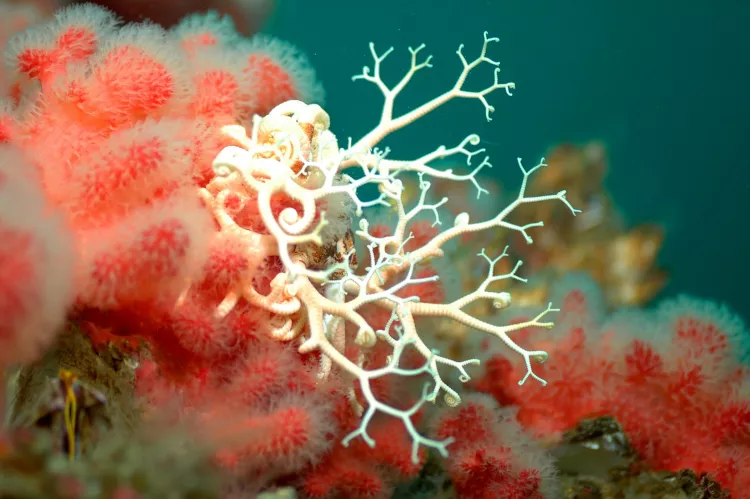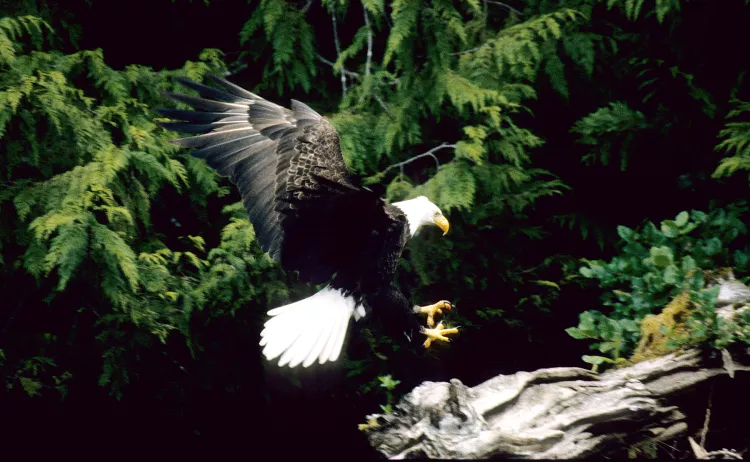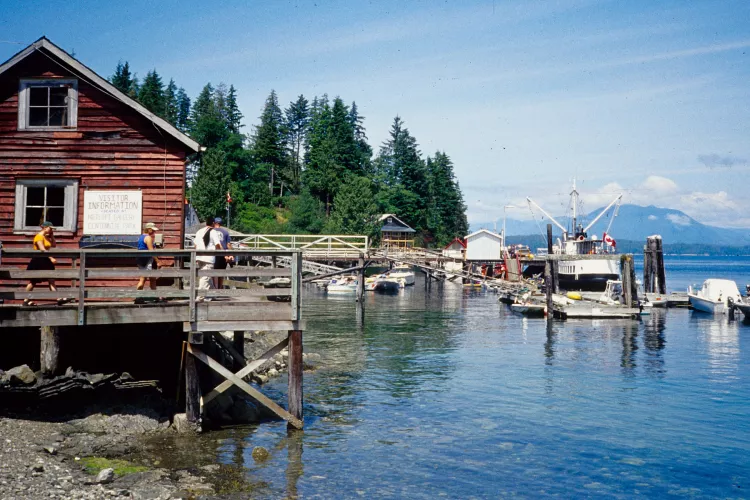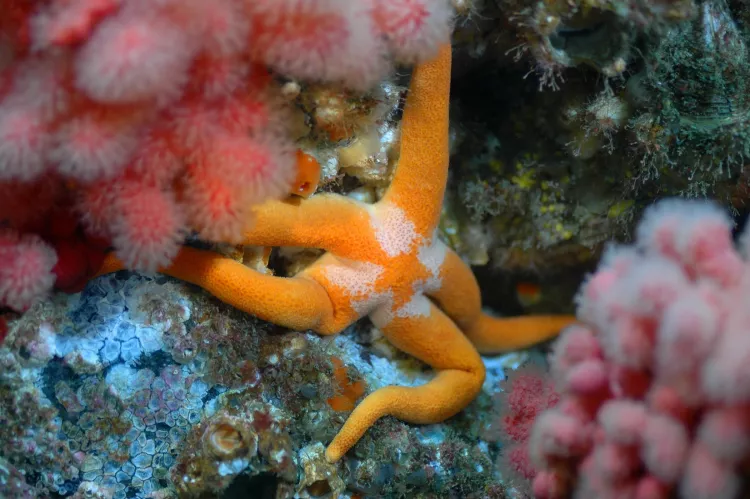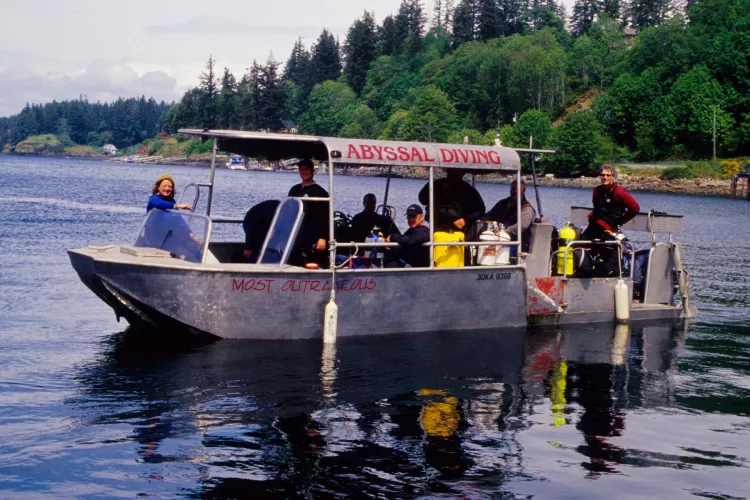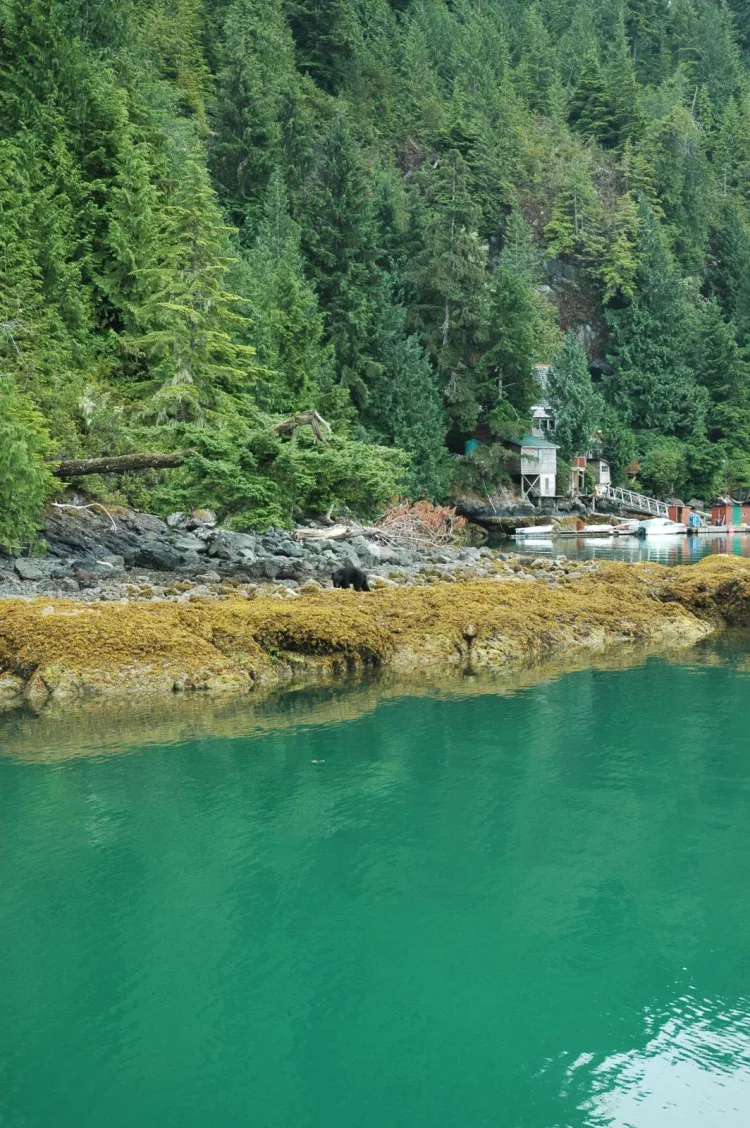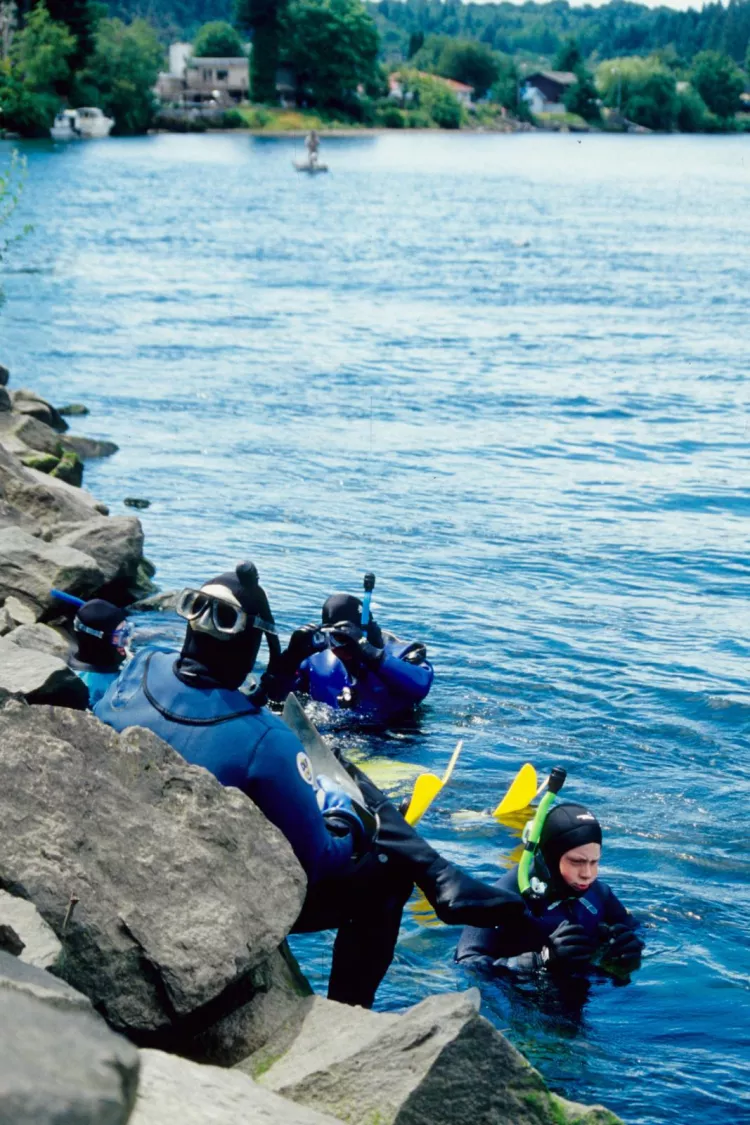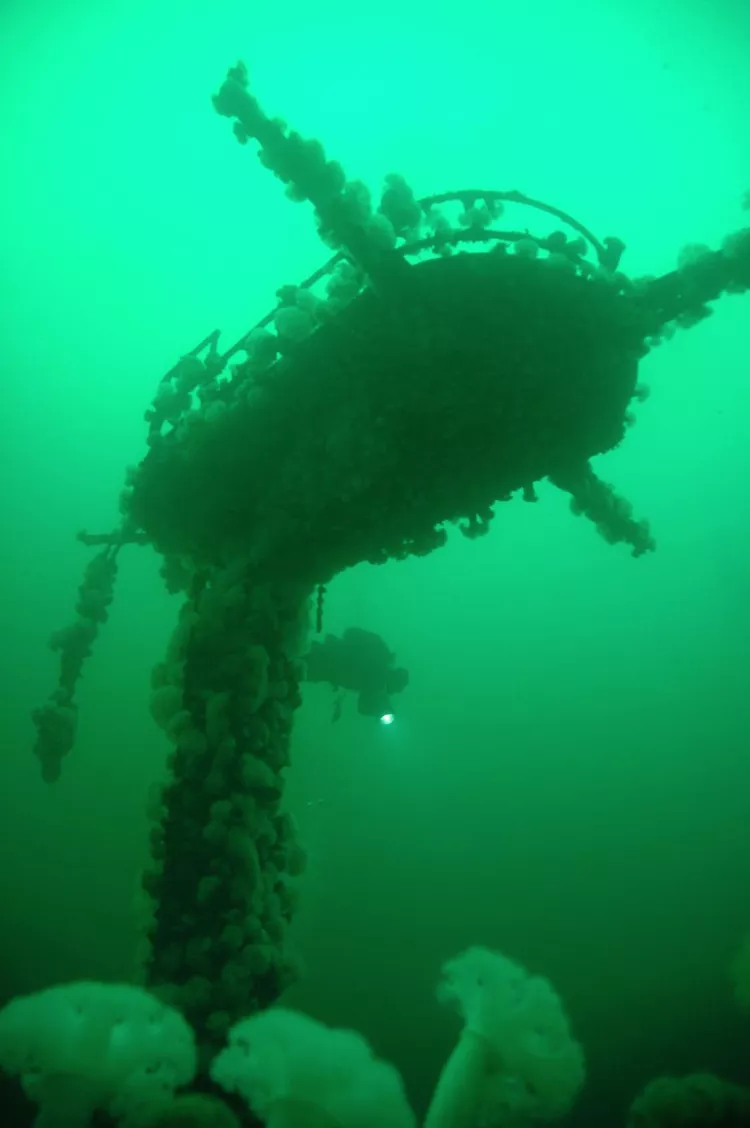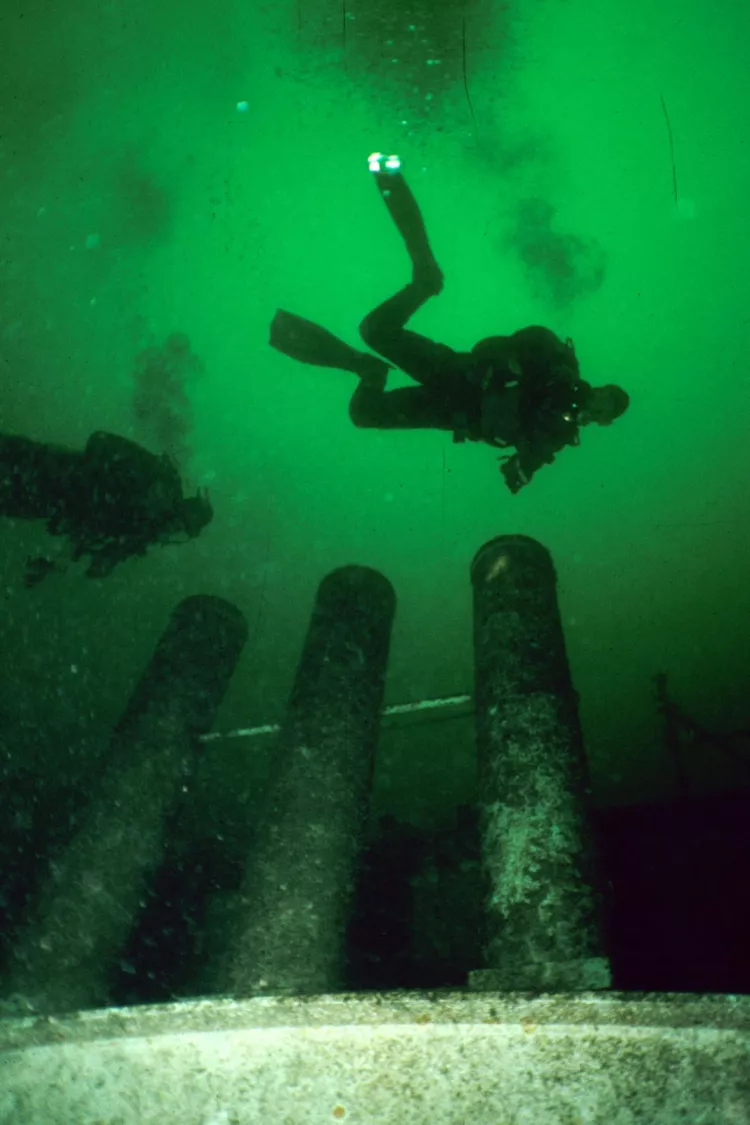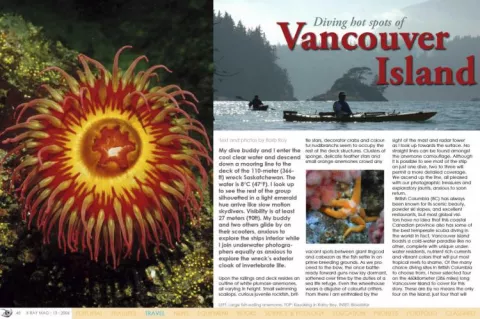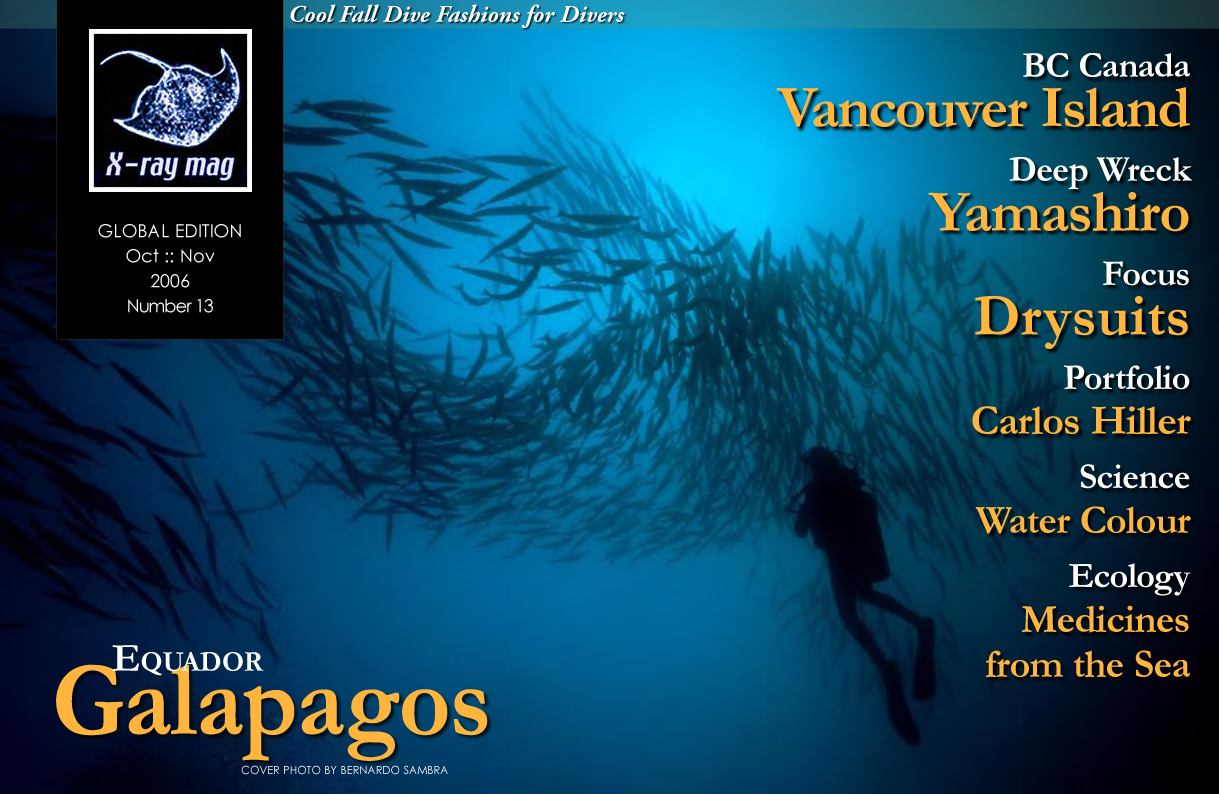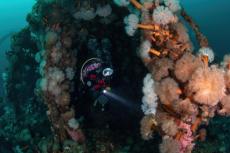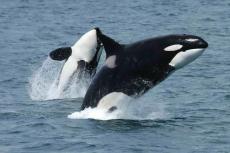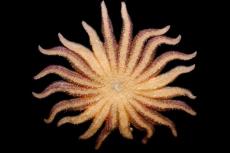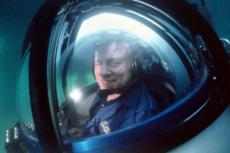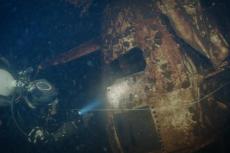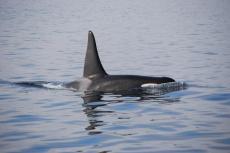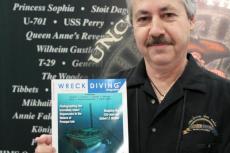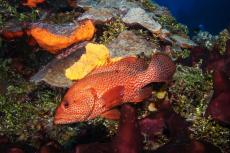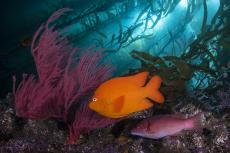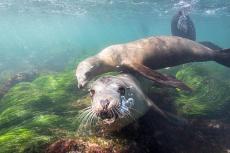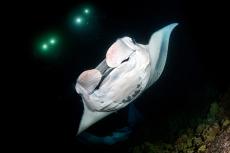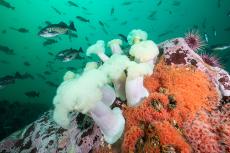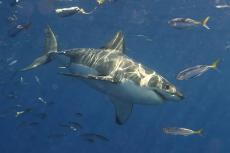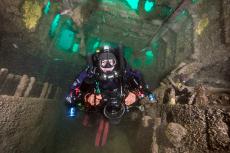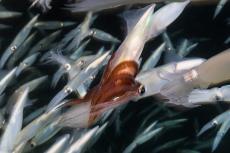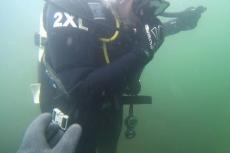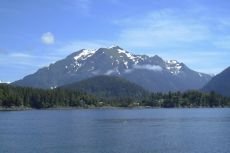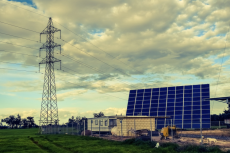My dive buddy and I enter the cool clear water and descend down a mooring line to the deck of the 110-meter (366-ft) wreck Saskatchewan. The water is 8°C (47°F). I look up to see the rest of the group silhouetted in a light emerald hue arrive like slow motion skydivers.
Contributed by
Upon the railings and deck resides an outline of white plumose anemones, all varying in height. Small swimming scallops, curious juvenile rockfish, brittle stars, decorator crabs and colourful nudibranchs seem to occupy the rest of the deck structures.
Clusters of sponge, delicate feather stars and small orange anemones crowd any vacant spots between giant lingcod and cabezon as the fish settle in on prime breeding grounds. As we proceed to the bow, the once battle-ready forward guns now lay dormant, softened over time by the duties of a sea life refuge. Even the wheelhouse wears a disguise of colourful critters.
From there I am enthralled by the sight of the mast and radar tower as I look up towards the surface. No straight lines can be found amongst the anemone camouflage. Although it is possible to see most of the ship on just one dive, two to three will permit a more detailed coverage. We ascend up the line, all pleased with our photographic treasures and exploratory jaunts, anxious to soon return.
British Columbia (BC) has always been known for its scenic beauty, powder ski slopes, and excellent restaurants, but most global visitors have no idea that this coastal Canadian province also has some of the best temperate scuba diving in the world! In fact, Vancouver Island boasts a cold-water paradise like no other, complete with unique underwater residents, nutrient rich currents and vibrant colors that will put most tropical reefs to shame. Of the many choice diving sites in British Columbia to choose from, I have selected four on the 460kilometer (286 miles) long Vancouver Island to cover for this story. These are by no means the only four on the island, just four that will portray BC’s incredible diversity.
When flying into this region there are three main airport terminals; Sea-Tac International in Seattle, Vancouver International on the BC mainland and Victoria International on Vancouver Island. Proof of citizenship is highly recommended when entering Canada. Many of the dive stores and operators offer travel packages, which include diving, accommodations, tanks and weights. Live-aboard dive boats commonly pick up in Vancouver, Nanaimo and Port Hardy. Rental dive gear is readily available throughout the island as well as specialized Nitrox, Trimix and Argon gas.
BC Ferries offer daily service from Tsawwassen or Horseshoe Bay on the mainland, across Georgia Strait to Duke Point or Departure Bay in Nanaimo, taking approximately two hours. When traveling at peak times, ferry reservations are a good bet and can be made on-line.
Nanaimo
I refer to Nanaimo as Vancouver Island’s “front door” because it opens up to a variety of diving activities to suit anyone’s needs. There are 8-12 excellent boat dives and several good shore dives to pick from. Popular wrecks include the retired naval ships Saskatchewan (111m/366f) and Cape Breton (122m/400f) scuttled as artificial reefs in 1997 and 2001 by the local dive community and the Artificial Reef Society of British Columbia (ARSBC). The latest edition is a 47m/157ft North Sea Rescue Tug Rivtow Lion scuttled in 2005. Technical and extended range divers like to practice their skills in and on the two larger wrecks while photographers and naturalists enjoy them all. Maximum depth on the Saskatchewan is 36m/120ft, the Cape Breton – 43m/142ft and the Rivtow Lion – 24m/80ft.
If wall diving is your pleasure, huge deep walls can be found at Snake Island and Orlebar, on Gabriola Island. The Snake Island wall has enormous white plumose anemones cascading down sandstone formations, dotted with bright pink snakelock anemones, red blood stars and orange finger sponge. I have also seen wolf eels out in the open at 12m/40ft and clusters of cloud sponge at depth. In between dives, snorkeling with resident harbour seals is always an option. Orlebar is steeper, hosting an array of odd shaped chimney sponge (boot sponge), tiger and quillback rockfish and an assortment of crustaceans. This is also a shore-accessible site utilized by technical divers.
As for drift diving, there are two narrow passageways where the currents reach 8 knots at full flow. This in turn provides a nutrient-rich environment for a multitude of invertebrate life to flourish. Both are divable during slack times (when the water stops to change direction). Dodd Narrows is located southeast of town between Nanaimo and Mudge Island. Brilliant giant green anemones and aggregating green anemones with pink tips line the shore of Mudge in the shallows, along with yellow zoanthids, orange cup corals, and metridium anemones on the boulders below. Patches of orange colonial tunicates, burrowing sea cucumbers and several species of rockfish can also be found at depth.
Gabriola Passage is equally as picturesque, hosting a population array similar to Dodd. In addition I have found red sea urchins, gray encrusting lobed ascidians, cabezon fish, grunt sculpins hiding in empty giant barnacle shells and the ever brave little painted greenlings. Small healthy aquarium-like kelp forests are located at both ends of both channels. When not diving, kayaking is one of the many fun activities to do. Kayak rentals and guided tours can be found in Nanaimo and on the artsy laid-back neighboring Gabriola Island (20-minute ferry ride from Nanaimo). Malaspina Galleries (sandstone overhangs) and the aboriginal petroglyphs on Gabriola is another attraction worthy of a stop. I wish to thank Ian Hall of Ocean Explorers Diving for taking us out on many memorable dive adventures during our Nanaimo visit!
Campbell River
The community encompassing Campbell River stretches close to 24km (15 miles) along the mid-eastern coast of Vancouver Island north of Nanaimo. Quadra Island lies parallel to the town with the narrow current swept Discovery Passage in between. A majority of the diving is located within Discovery Passage along the Quadra Island side. Current slack times must always be followed and are well known by local dive charter operators.
In 1996, the ARSBC scuttled the retired 111m/366ft Columbia in northern Discovery Passage off Maud Island. The vessel is not as populated as the two in Nanaimo, but its six back mortar guns are very impressive. I have photographed three large giant Pacific octopuses next to the ship at 28m/95ft as two males courted a female. Around the corner is Seymour Narrows where whirlpools and standing waves form during full flow. For an underwater observer it is anemone heaven. Tan and yellow staghorn bryozoans, green urchins, China and quillback rockfish, and orange tennis ball sponge are all over this rocky terrain.
Copper cliffs or bluffs are as interesting above water as below. Minerals seem to bleed through exposed topside rock leaving it rippled in green. Below water is a colorful wall with ledges and huge algae covered boulders. Rose sea stars, juvenile box crabs, red Irish lords, and cup corals are just a few of the many residents. Massive clusters of giant purple-plumed feather duster tube worms can be found at Steep Island and a carpet of pink and red strawberry anemones are always a treat at Whiskey Point. On a single dive here I counted four large Puget Sound king crabs! End-of-the-road is similar, yet more of a nursery with young octopus and sculpins hiding amongst the blanket of invertebrates.
If weather permits, a day excursion south to Mitlenatch Island and the nearby wreck of the Capilano is well worth an extra day. Located on the south side of Grant Reef, between Savary and Harwood Islands, the 36m/120ft Capilano sits upright in 30-43 meters (100-145 feet) covered in a shroud of giant white plumose anemones. Here you will find lingcod, an assortment of gargantuan rockfish and bouquets of yellow and white cloud sponge. The wreck’s natural beauty creates exceptional video footage for documentation. Another excellent site for diving and wildlife viewing is the semi-arid island of Mitlenatch. In Coast Salish language “Mitlenatch” means ‘calm water all around’. On a sunny day in May the island’s wildflower meadows explode in color. Due to the large number of nesting sea bird colonies Mitlenatch was designated a Provincial Nature Park in 1961.
Today, the island is home to the largest seabird colony in Georgia Strait, attracting Glaucous-winged gulls, pelagic cormorants, pigeon gillemots and black oystercatchers. Otters, harbour seals, Steller’s and California sea lions can be found lounging on smooth warm boulders along the eastern coast, with heavier concentrations occurring between November and May. When not diving, visitors might want to check out a salmon snorkel float down the Campbell River during the annual salmon run in mid-July through early October. I would like to extend a thank you to Earl Lowe with Abyssal Dive Charters for introducing us to some awesome dives!
Port Hardy
This gateway to the Inside Passage and the Queen Charlotte Strait is located at the northern end of the Island Highway. Most of the diving in this area is done from live-aboard boats, land based resorts or remote lodges with small fast boats, departing from Port McNeill (south of town) or Port Hardy. Currents vary, allowing a wide selection of sites to choose from. Perhaps the most famous site is the prolific Browning Wall, located in Browning Passage on the south eastern side of Nigei Island. Strong currents feed the multitudes of life so well it is rare to find an area void of life. During one of my winter visits, my buddy and I could see the boat and trees above from 27m/90ft! Hordes of red, pink, and orange soft coral flourish at this site next to arm-length clusters of glove sponge, ruffled orange-peel nudibranchs and white-spotted rose anemones. Macro photographers should keep an eye out for tiny white or yellow sea spiders, found covering strands of sea strawberry soft coral.
Seven Tree Island also flanks Nigei and is another lush site where I have always had good luck finding the illusive decorated warbonnets, mosshead warbonnets and an endless supply of rockfish. Barry Islet offers fields of miniature red, pink and white gorgonians, some even hosting small basket stars. Macro subjects at Dillon include purple-ringed topsnails, several species of nudibranchs and bright orange juvenile Puget Sound crabs. Larger subjects at Dillon include octopus, ancient-looking ratfish and friendly wolf eels. On the north side of Crocker Rock, at the northern entrance to Browning Passage, the remains of the Themis can be found half in a forest of kelp and half covering a reef. At 12m/40ft the area clears somewhat, revealing weathered ribs and twisted sections of metal down to 21m/70ft. Although a bit unsightly, the distorted garble wears a colorful invertebrate cloak of textured life. Both harbour seals and sea lions have been sighted here. Keep an eye out for the bathtub!
Weather permitting, I have always enjoyed spending the day across the Strait exploring Slingsby Channel. Almost anywhere along the outer walls are excellent for photography or nature watching, above and below the water. Talk about seeing everything on a single dive, these walls deserve nothing less than a two-GB memory card with a macro or close-up lens! Turret Rock (aka Tremble Rock) is another close site, in the middle of Nakwakto Rapids. Recorded at speeds of up to 22 knots, these fast-moving currents will take your breath away! Below the surface a diver will find huge clusters of unique Nakwakto goose-neck barnacles with ‘red’ lips and six-rayed white sea stars.
Large schools of Pacific white-sided dolphins tend to frequent the area around Nigei, presenting the opportunity for divers to see these fast moving critters in action. In mid-water when we have encountered them, they have always put on a spectacular show! Be sure to have a weighted reference line because they will spiral around you, sending you deeper than planned. When not diving, kayak exploration in the calm bays and coves is both fun and easy. Paddlers have the opportunity to see black bears, orcas, porpoise, eagles, sea birds, otters, harbor seals and river otters. I would like to thank John deBoeck of Browning Pass Hide Away on Nigei Island for sharing his area expertise and site knowledge. The orca rubbing beach was amazing!
Barkley Sound
Located within the boundaries of the Pacific Rim National Park on the west coast of Vancouver Island, Barkley Sound has always been a favorite among divers. This unique wild coast wonderland is easily accessed by boat from Port Alberni, via the narrow 40km/25mi Alberni Inlet. An 89km/56mi gravel logging road from Port Alberni to Bamfield provides another access. Diving is available year-round from several operators offering both day and multi-day excursions. With over 100 islands in the Broken Group alone, it’s easy to find a dive site even if the weather doesn’t cooperate. Chup Point is a favorite of mine for macro photography, night diving and being able to spot over five different species of rockfish on a single dive! The depths vary from shallow to deep with little to no hint of currents. The colorful assortment of nudibranchs includes; yellow and white dorids, orange-peel nudibranchs, frosted and opalescent nudibranchs. Perhaps Renate’s Reef should have been called “Wolf eel city” because of its numerous long gray residents of varying length and age. It’s a rare occasion that I am not able to photograph at least five on a dive. Octopus, china and tiger rockfish and medium size lingcod also reside here.
Tyler rock is special because the first time I dove here I was greeted by eight six gill sharks, the largest one a female at over 3.6m/12ft! Waterfalls of white plumose anemones spill over steep slopes beginning at the top of the reef. Ratfish, orange sea pens, octopus and sculpins can be found at 27m/90ft upon a sandy bottom within a valley separating two reefs. Unfortunately, recent sightings have not yielded as many, but other six gill sites are being discovered each year. Although Barkley Sound has several shipwrecks to explore, there are two easily accessible ones: the Vanlene and an abandoned Chinese migrant ship scuttled as an artificial reef in 2003. Not much remains of the 142m/473ft freighter Vanlene since it went down in 1972 near Austin Island except sheets of mangled steel and knarled sections of hull structure. It too has broken apart from years of wild weather and storms. In the midst of this twisted turmoil, I have spotted adult Puget Sound king crab, multi-colored sunflower stars, rockfish, California sea cucumbers and abalone to photograph.
The Vanlene’s bow can be found in the shallows as the rest of the ship seems to unfold down the bank like a broken puzzle to over 30m/100ft. The migrant ship is approximately 30m/100ft in length and sits upright with a maximum depth of 28m/95ft, near Canoe Island in Sechart Channel. The hull and wheelhouse are easy to explore, but we found most of the life growing on the outer hull and bow area. When not diving, humpback and gray whale watching is superb during the warm summer months. Kayaking is another way to take in the areas magnificent scenery and wildlife. I would like to thank Peter and Kathy from Rendezvous Dive Adventures for taking us out and letting us use their kayaks for a great photo shoot!
Water temperature doesn’t change much from one end of the island to the other, staying between 6-11°C (43-52°F) between November and April, increasing to 8-15°C (47-59°F) between May and October. This in turn requires a diver to wear full-body thermal protection in the form of a dry suit or a thick 6.5mm wetsuit. Please remember, when visiting British Columbia, as with most prime dive destinations, the taking of marine life on dive trips is frowned upon and not permitted by most operators. Enjoy nature’s cold water paradise as a respectful visitor, because it will take you more than ten return trips to see a mere portion of British Columbia’s underwater wonders. ■
Published in
-
X-Ray Mag #13
- Läs mer om X-Ray Mag #13
- Log in to post comments

